

Tree to 20 m (65 ft) tall and 50 cm (18 in) diameter, with irregular spreading crown, often leaning over water from a riverbank. Bark shiny pinkish-brown or silvery-gray, separating into papery scales, becoming thick, rough, and shaggy on older trunks and branches. Twigs slender, reddish brown, hairy when young, buds pointed, hairy when young, becoming shiny brown. Leaves alternate, usually ovate, 4-7.5 cm (1.6-3 in) long and 2.5-6 cm (1-2.4 in) wide, coarsely double-serrate, with 7-9 straight veins on each side, shiny dark green above, whitish-green and usually hairy below. Staminate flowers appear in early spring as cylindrical catkins 5-7.5 cm (2-3 in) long. Pistillate flowers and fruits are in conelike structures about 1 cm (0.4 in) long in early spring, becoming 2.5-4 cm (1-1.6 in) long at maturity in the Fall.
Habitat: streambanks and wet floodplain forests.
Distribution: The species is native to about the southeastern 1/3 of the United States.
NWI status: FACW
Comment: Betula is the ancient classical name for the birches; nigra means "black", although no part of the tree is black.
Distribution in Oklahoma: 
BACK
NEXT
RETURN TO INDEX
Last update: 9/8/99
 Go to Oklahoma Biological Survey Home Page
Go to Oklahoma Biological Survey Home Page
 Disclaimer
Disclaimer